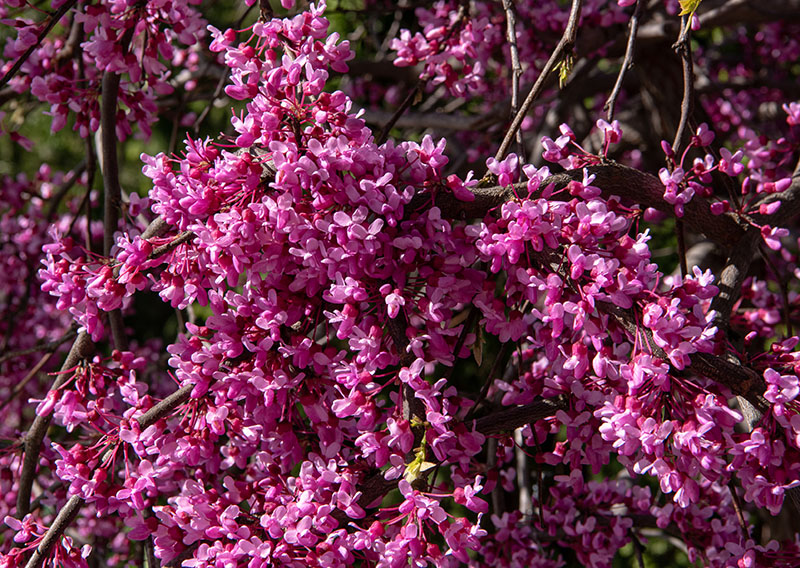

Tips & Techniques
Trees and Shrubs for Spring Color

Eastern redbud (Cercis canadensis)
As the spring season unfolds, spring-flowering trees can raise the show of new color from ground level to eye level and above. Read on for some good choices if you want to raise the bar on spring color within your landscape.
On with the Show
Eastern redbud (Cercis canadensis)
Eastern redbud is a small-scale tree with big impact. A Midwestern native plant growing 15 to 25 feet tall, eastern redbuds often have short trunks that begin branching close to the ground. Purple-pink flowers in March or April bloom directly on branches and mature trunks. After their early springtime show, it’s glossy, heart-shaped leaves up to 5 inches that give redbud its summertime appeal. In native habitats, redbud grows as an understory tree in partial shade and soil that is naturally rich with organic matter. In cultivated gardens, redbud feels at home in dappled shade, but performs well in full sun as long as soil is consistently moist.
Cornelian cherry dogwood (Cornus mas)
Cornelian cherry dogwood offers some of the earliest spring flowers, vibrantly colored summer fruits, and exfoliating bark that adds rich visual interest to winter gardens. Naturally a multistemmed shrub, many gardeners aggressively prune suckers and remove lower limbs to turn cornelian cherry into a small tree that grows 15 to 25 feet tall and wide. Clusters of tiny, star-shaped flowers bloom in late March or April and last up to three weeks when temperatures are seasonably cool. A remarkably pest-free plant, its edible fruits are easy to grow organically. Cornelian cherry dogwood prefers full sun to partial shade and moist, well-drained soil.
Flowering quince (Chaenomeles x superba)
Exceptional showy orange, white, or pink flowers make flowering quince a standout in the April garden. Eventually growing 3 to 4 feet tall and wide, reddish-bronze leaves in spring eventually turn dark green. Its green fruits are high in pectin and make good homegrown and homemade jellies and preserves. A naturally twiggy and sometimes tangled habit makes annual pruning (immediately after flowering) strongly recommended for keeping plants looking tidy. But beware! Sharp spines on the species and some cultivated varieties make flowering quince an excellent barrier plant. Plants prefer full sun to partial shade and moist soil, but tolerate dry soil and windy sites.
Carolina silverbell (Halesia tetraptera)
A less familiar spring-flowering tree or multistemmed shrub, it takes but a glimpse of Carolina silverbell’s dangling, bell-shaped flowers to understand why it was selected as one of Illinois’ Best Plants. Clusters of white flowers in April or May — appearing at the same time or slightly before leaves emerge — become nutlike fruits that persist into winter. Trees grow 25 to 40 feet tall, have a rounded habit, and furrowed bark that adds interest to winter gardens. Found growing as understory trees in native habitats, Carolina silverbell prefers dappled shade but should have moist, acidic soil.
Crabapple (Malus spp. and cvs.)
Considered by many to be the best of the spring-flowering trees, nurseries and breeders have provided homeowners with an extensive array of beautiful options. Crabapples offer a range of heights (from 8 to 30 feet) and habits (rounded, columnar, pyramidal, oval, and weeping), and different combinations of flower bud, blossom, and fruit colors. Gardeners looking to reduce their use of garden chemicals select disease-resistant species or newer varieties. Crabapples perform best in full sun and well-drained soil, and when their canopies are pruned to increase sunlight penetration and air circulation. Disease-resistant varieties are good selections for urban environments.

